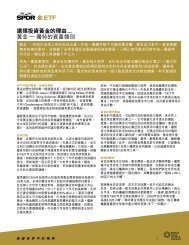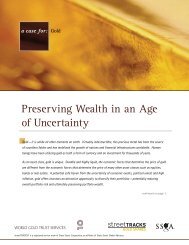You also want an ePaper? Increase the reach of your titles
YUMPU automatically turns print PDFs into web optimized ePapers that Google loves.
Appendix I: <strong>Gold</strong> and currenciesHistory<strong>Gold</strong> is the world’s oldest global currency, having played arole in most currency systems for more than two thousandyears. <strong>Gold</strong>’s use as a unit of exchange can be traced back tothe ancient Kingdom of Lydia, present-day Turkey, c. 500 BC.Croesus, King of Lydia, is credited with issuing the first goldcoins containing a standardised amount of pure gold, whichwas subsequently adopted by other civilizations across theMediterranean region.<strong>Gold</strong>’s physical properties make it ideal for use as a currency.It is scarce, it doesn’t tarnish or corrode, it is malleable andits nearly uniform status across civilizations as a valuablepossession has made it a rationale unit of exchange. Charlesde Gaulle famously asserted: “there can be no other criterion,no other standard than gold. Yes, gold which never changes,which can be shaped into ingots, bars, coins, which has nonationality and which is externally and universally accepted asthe unalterable fiduciary value par excellence”.Over the centuries, the use of specie money was overtaken bya gold and silver standard, where the metals backed the value offiat money. As the world’s monetary system evolved, metalliccoins were given up in favour of gold-backed bank notes wherebanking institutions took deposits and made loans backed bygold. This allowed consumers to use currencies to purchasegoods with the guarantee that one could exchange bills forgold or silver.Great Britain was the first country to move to a pure goldstandard in 1717, when the government linked the currencyto gold at a fixed rate. By the turn of the 20th century, mostcountries were on a pure gold standard. Most countries leftthe gold standard after World War I in order to monetisetheir ballooning debts, but the US chose to remain with thestandard. A new monetary system, commonly referred to asBretton Woods, was put in place after World War II, wherebya country’s currency was linked to the US dollar and ultimatelybacked by the US government’s gold commitment to buy goldat a fixed price.After years of trying economic times and numerous costly wars,US President Nixon decided to suspend the direct convertibilitybetween the US dollar and gold, ending the gold-exchangestandard. This decision effectively set the stage for the floating(fiat) currency system that we know today.<strong>Gold</strong>’s use in the monetary systemWhile gold’s use as a currency has diminished since the goldstandard era, it has become increasingly relevant in the globalmonetary system, particularly over the last few years. Forexample, investors who access securities through the ChicagoMercantile Exchange (CME) and the Intercontinental Exchange(ICE) are able to use gold as high-quality collateral for thepurchase of other assets. These exchanges rank gold’s collateralvalue on par with some other foreign currencies and majorgovernmentbond markets.<strong>Gold</strong> <strong>Investor</strong> | Risk management and capital preservation










